Cyril Roger Brossard
Well-known member
- Joined
- Aug 30, 2012
- Messages
- 408
As seen in on-board magazine Discovery (april2011) of Cathay Pacific.
A bit old but some readers may enjoy the pictures if not the text.
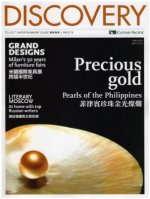
Page1
Producing exotic beauties like this isn?t easy, but experts in the South Sea islands have pearl farming down to a fine art.
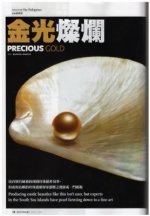
Page2
Oysters are seeded and submerged in the South Sea to produce top-quality pearls.

Page 3
The warm and clear waters lapping the remote islands of the southern Philippines are an underwater paradise: divers come here from all over the world to revel in this ocean?s bountiful treasures. However, unknown to many, these waters are the cultivation ground of an even more glorious treasure: golden South Sea pearls.
The Philippines is one of the top producers of these large, lustrous beauties and there are close to 30 farms spread through the archipelago?s southern islands.
South Sea pearls are cultured in Pinctada maxima oysters in the mild, remote waters from Australia to Indonesia, Myanmar and Thailand and are produced in a variety of colours depending on the oyster?s shell colours, usually visible at the edge of the lip, of the oyster.
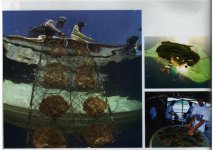
A gold-lip oyster produces golden pearls, a white-lip oyster a white pearl, while their black-lipped cousin, Pinctada margaritifera, producesa range of dark pearls better known as Tahitian pearls, which are cultured in the atolls of French Polynesia.
In The Philippines, pearl production hinges on the huge advances made in biotechnology: farms have highly qualified marine biologists and state-of-the-arts labs to research the ideal conditions required to produce the most desirable pearls. The research extends from oyster-breeding in hatcheries to preparing the most nutritious plankton soup to feed the young molluscs, as well as techniques in oyster seeding and equally elaborate processes of aftercare.
Research has confirmed that pearl formation is a process of bio-crystallisation: the mantle tissue of the oyster secretes parallel layers of crystals and alternate layers of glue to form the other-of-pearl layer in the oyster?s shell. In pearl culture, a piece of this living mantle tissue is used to stimulate the oyster to cover the bead with the same layers. A eureka moment was the discovery that concentric crystallisation required to produce round pearls happens only in the oyster?s reproductive sac.
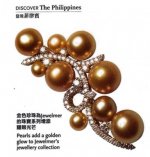
When the oysters reach maturity, about two years after they are moved from the hatcheries, they are ?seeded? with a round bead that becomes the nucleus of the pearl and is made only from the shell of a freshwater mussel from the Mississippi River in the United States. The nucleation, or seeding operation, is usually performed by expert technicians from Japan, the country that developed the process of pearl culture almost 100 years ago. These experts gently open the reproductive sac, insert a bead and a sliver of living tissue from a donor oyster, and hope that the mantle tissue will grow quickly to encircle the bead and secrete layers that will change the bead into a golden beauty.
After recovery, the oysters are transferred to mesh panels that are suspended on floating cables in the ocean, where they live and grow for about two more years. During this time the oyster is busy producing the pearl and its progress and health are checked with occasional x-rays.
Back in the lab, the oyster is gently prised open and out pops a shiny golden orb. These pearls are large: from nine to 16 millimeters, the larger ones are possible because of techniques that facilitate second operations, where a larger bead is inserted into the cavity after the first harvest.
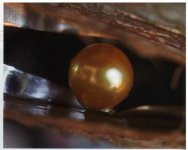
Nothing follows.
A bit old but some readers may enjoy the pictures if not the text.

Page1
Producing exotic beauties like this isn?t easy, but experts in the South Sea islands have pearl farming down to a fine art.

Page2
Oysters are seeded and submerged in the South Sea to produce top-quality pearls.

Page 3
The warm and clear waters lapping the remote islands of the southern Philippines are an underwater paradise: divers come here from all over the world to revel in this ocean?s bountiful treasures. However, unknown to many, these waters are the cultivation ground of an even more glorious treasure: golden South Sea pearls.
The Philippines is one of the top producers of these large, lustrous beauties and there are close to 30 farms spread through the archipelago?s southern islands.
South Sea pearls are cultured in Pinctada maxima oysters in the mild, remote waters from Australia to Indonesia, Myanmar and Thailand and are produced in a variety of colours depending on the oyster?s shell colours, usually visible at the edge of the lip, of the oyster.

A gold-lip oyster produces golden pearls, a white-lip oyster a white pearl, while their black-lipped cousin, Pinctada margaritifera, producesa range of dark pearls better known as Tahitian pearls, which are cultured in the atolls of French Polynesia.
In The Philippines, pearl production hinges on the huge advances made in biotechnology: farms have highly qualified marine biologists and state-of-the-arts labs to research the ideal conditions required to produce the most desirable pearls. The research extends from oyster-breeding in hatcheries to preparing the most nutritious plankton soup to feed the young molluscs, as well as techniques in oyster seeding and equally elaborate processes of aftercare.
Research has confirmed that pearl formation is a process of bio-crystallisation: the mantle tissue of the oyster secretes parallel layers of crystals and alternate layers of glue to form the other-of-pearl layer in the oyster?s shell. In pearl culture, a piece of this living mantle tissue is used to stimulate the oyster to cover the bead with the same layers. A eureka moment was the discovery that concentric crystallisation required to produce round pearls happens only in the oyster?s reproductive sac.

When the oysters reach maturity, about two years after they are moved from the hatcheries, they are ?seeded? with a round bead that becomes the nucleus of the pearl and is made only from the shell of a freshwater mussel from the Mississippi River in the United States. The nucleation, or seeding operation, is usually performed by expert technicians from Japan, the country that developed the process of pearl culture almost 100 years ago. These experts gently open the reproductive sac, insert a bead and a sliver of living tissue from a donor oyster, and hope that the mantle tissue will grow quickly to encircle the bead and secrete layers that will change the bead into a golden beauty.
After recovery, the oysters are transferred to mesh panels that are suspended on floating cables in the ocean, where they live and grow for about two more years. During this time the oyster is busy producing the pearl and its progress and health are checked with occasional x-rays.
Back in the lab, the oyster is gently prised open and out pops a shiny golden orb. These pearls are large: from nine to 16 millimeters, the larger ones are possible because of techniques that facilitate second operations, where a larger bead is inserted into the cavity after the first harvest.

Nothing follows.
